HyperCube™ (Hyperspectral CubeSat)
EO
Atmosphere
Atmospheric Humidity Fields
Atmospheric specific humidity (column/profile)
Quick facts
Overview
| Mission type | EO |
| Agency | L3Harris |
| Mission status | Planned |
| Measurement domain | Atmosphere |
| Measurement category | Atmospheric Humidity Fields, Atmospheric Winds |
| Measurement detailed | Atmospheric specific humidity (column/profile), Wind profile (horizontal) |
| Instruments | HyperCube Instrument |
| Instrument type | Atmospheric temperature and humidity sounders |
| CEOS EO Handbook | See HyperCube™ (Hyperspectral CubeSat) summary |
HyperCube™ (Hyperspectral CubeSat Mission - 3D Wind Measurement)
Accurate wind measurement information has been identified as a top priority to improving weather forecasting models. Harris provides HyperCube, a cost-effective solution. HyperCube is a spaceborne three-dimensional sounding instrument designed to measure the speed, direction, and elevation of wind in Earth's atmosphere. A Fourier Transform Spectrometer, the HyperCube 6U CubeSat is much smaller and less expensive than conventional systems, and offers a more expedient implementation alternative to complex LiDAR wind measurement programs. 1)
Enabled by the sounding technology of Harris, HyperCube provides hundreds of hyperspectral bands for the best instrument resolution in the small satellite market. It delivers more vertical layers of wind vector data at fine spatial resolution, resulting in more accurate data than other available solutions.
Data accuracy is maintained using an onboard calibration target capable of precise, absolute calibration. HyperCube™ also offers collection time flexibility, allowing for more mission coverage than alternative technologies.
The design of HyperCube improves upon the highly successful CrIS (Cross-track Infrared Sounder) aboard the Suomi NPP satellite. The CrIS, also a Fourier transform spectrometer, has been providing more accurate atmospheric temperature, pressure, and moisture observations since 2011. Harris packages this proven technology in a smaller, lower mass solution, called the HyperCube CubeSat.
The smallsats are developed in connection with the SDL/USU (Space Dynamics Lab of Utah State University), who provides the spacecraft for the HyperCube mission.
The HyperCube Mission and Operational Concept
HyperCube is a constellation of 6U CubeSats equipped with MWIR (Mid-Wave Infrared) hyperspectral instruments. The instruments measure three-dimensional (3D) distributions of atmospheric water vapor, and by measuring the same region of the atmosphere at different times, they are able to infer wind velocities at multiple vertical locations in the atmosphere (i.e., 3D wind measurements).
An operational CubeSat constellation would consist of 12 satellites, grouped into four "triplets" of satellites that have identical ground tracks but separated by about 15 minutes. The swath width allows for full global 3D wind measurements every 6 hours. This allows frequent wind data ingestion into numerical weather forecast models.
The HyperCube satellite consists of two major sections; the instrument section and the spacecraft section. The instrument contains an FTS (Fourier Transform Spectrometer)-based hyperspectral sounder, and its design utilizes heritage components from prior Harris hyperspectral instruments. The instrument includes an FTS interferometer, a cross-track step-stare scanner, a compact aft-optics telescope, a two-dimensional (2D) infrared FPA (Focal Plane Array), and an internal calibration target.
The step-stare scanner performs cross-track step-stares, each with a fixed stare time. Earth radiance passes through the scanner and feeds a corner-cube Michelson interferometer. The interferometer performs an OPD (Optical Path Difference) sweep and creates a double-sided interferogram in each sweep. Simple focusing optics behind the interferometer place the optical beam onto a 2D FPA. The FPA is cooled to cryogenic temperatures using a two-stage passive cooler, similar to the cooler used by the Harris HIRS (High-resolution Infrared Radiation Sounder) instrument, with some new, innovative advancements to fit in the compact CubeSat geometry.
The mass of the full satellite is 12.2 kg, while the overall volume is 11.6 x 24 x 36.6 cm (6U). The instrument section requires 11 W of the total 21 W power distribution.

HyperCube Flight Demonstration Mission
Harris is developing a flight demonstration version of a HyperCube satellite that could be flown as early as 2019. During the flight demonstration, HyperCube will collect different types of data to demonstrate different types of missions. MWIR spectra, with high spatial and spectral resolution, will be collected providing moisture profiles at various altitudes in the atmosphere. Retrievals will be compared with those of CrIS (Cross-track Infrared Sounder) on Suomi NPP, AIRS (Atmospheric Infrared Sounder) on Aqua, and IASI (Infrared Atmospheric Sounding Interferometer) flown on MetOp. On subsequent passes of the CubeSat over the polar regions, polar winds are extracted from two 3D moisture data cubes. Simultaneous nadir overpasses with CrIS and IASI are used to demonstrate calibration accuracy. An alternate collection method will allow trace atmospheric gases to be detected.
Figure 2 and Figure 3 show the overall design of the HyperCube flight demonstration satellite.
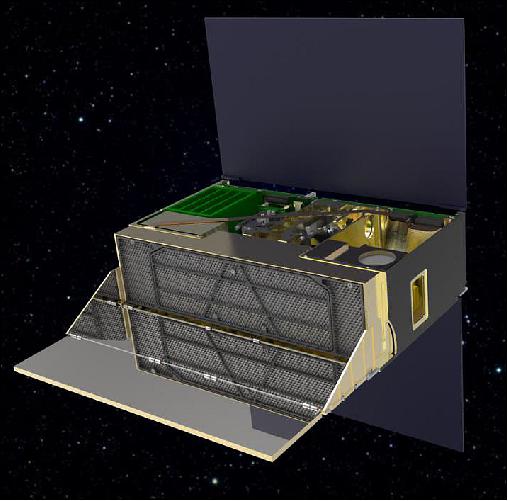
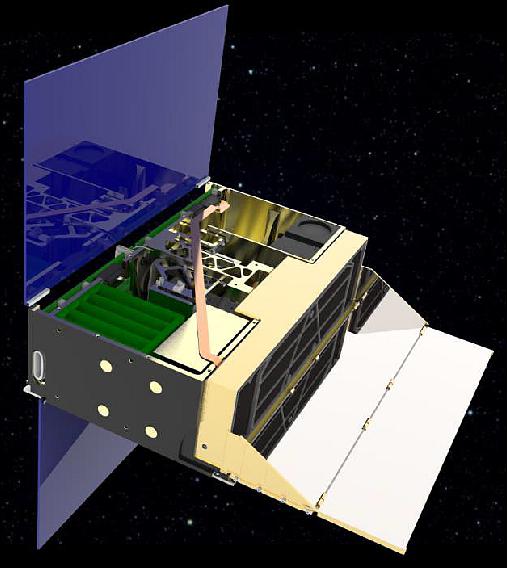
Flight Demonstration Instrument Details
Photographs of the key HyperCube instrument components are shown in Figures 4 and 5. Figure 3 shows the main optomechanical portion of the instrument, which includes the cross-track step-stare scanner, internal calibration target, cornercube interferometer, and aft optics. Figure 5 shows the FPA used in the flight demonstration. It is a 6 x 6 MWIR FPA with a 9.5 µm cutoff.
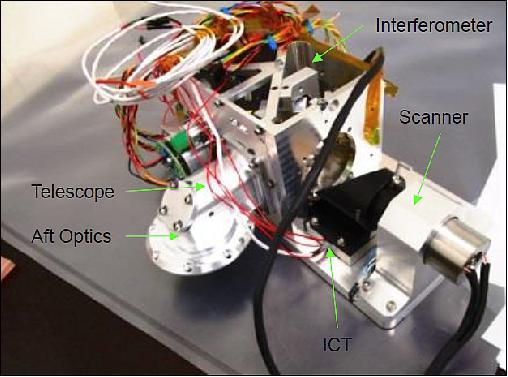
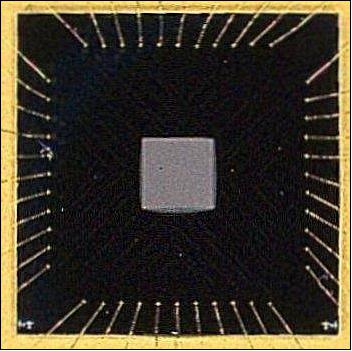
Instrument Environmental Test Program
Near-term goals of the flight demonstration program were to demonstrate the maturity of the HyperCube instrument technology and confirm that it is ready for launch. These have now been achieved.
The HyperCube instrument has undergone a complete space environmental test program. This included an initial TVAC (Thermal-Vacuum) test to establish baseline instrument performance and show vacuum operation, a vibration test to prove that the instrument was capable of surviving typical launch conditions, and a post-vibration TVAC to verify that the instrument was functional after vibration and that its performance had not been degraded by the vibration exposure. Figure 5 shows the instrument in TVAC. The instrument is shown attached to a fixture that serves both as the cooler for the detectors and as the vibration test fixture. No significant issues were observed during the vibration test. Figure 7 is a photograph of the instrument while in vibration test.
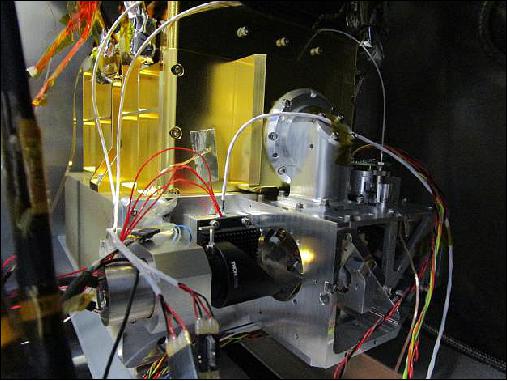
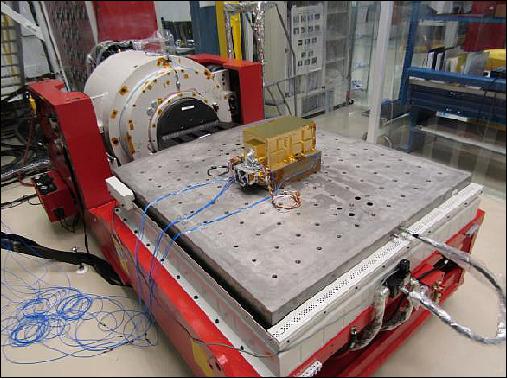
The noise equivalent spectral radiance (NEdN) performance of the HyperCube instrument was recorded in TVAC before and after vibration testing. Data collected during TVAC were consistent with NEdN simulations, and no changes were noted due to environmental exposure.
Since the HyperCube instrument has now been successfully exposed to a relevant space environment, it is now considered to be at TRL6 (Technology Readiness Level 6). Harris is currently in the process of completing the build of the remainder of the HyperCube satellite, with the goal of having it ready for launch in 2019.
References
1) "HyperCubeTM3D Wind Measurement," Harris Corporation, 2017, URL: https://www.harris.com/sites/default/files/downloads/solutions/55493_hypercube_data-sheet_v2_2_final_.pdf
2) Ronald Glumb, Michael Lapsley, Peter Mantica, Anna Glumb, "TRL6 Testing of Hyperspectral Fourier Transform Spectrometer Instrument for CubeSat Applications," Proceedings of the 31st Annual AIAA/USU Conference on Small Satellites, Logan UT, USA, Aug. 5-10, 2017, paper: SSC17-VI-08,URL: http://digitalcommons.usu.edu/cgi/viewcontent.cgi?article=3641&context=smallsat
The information compiled and edited in this article was provided by Herbert J. Kramer from his documentation of: "Observation of the Earth and Its Environment: Survey of Missions and Sensors" (Springer Verlag) as well as many other sources after the publication of the 4th edition in 2002. - Comments and corrections to this article are always welcome for further updates (eoportal@symbios.space).